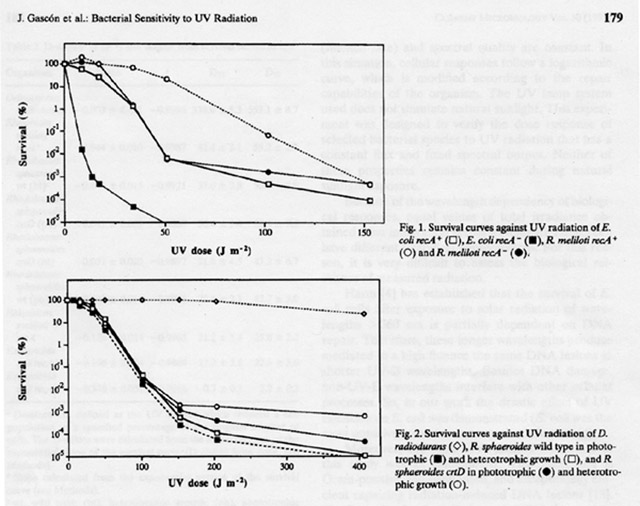In Fig. 2, the Gram stain shows Gram positive rods without spores from the lack of clearing in the rods. An endospore stain did not show spores. Even though we were searching for cocci, we continued to test this isolate because some Deinococcaceae forms rods. Pure colonies of the isolated organism were obtained through streak plating and used to grow in nutrient broth. After incubation for 48 hours, 100 mL aliquots were spread plated on TSA and NA + 7.5% NaCl plates. Figures 3-5 shows the growth of the organism 7 days after exposure to UV radiation for 5, 10 and 15 minutes. On all plates (Fig. 3-5), there was growth of pigmented colonies, showing that they are osmotolerant and UV resistant. Growth around the edge of the plates shows the shielding effect of plastic but there is growth away from the perimeter as well. In comparison, figures 6-8 shows the growth of E.coli grown overnight on TGY. E. coli is very susceptible to UV radiation as seen by the graph below in Fig 13. At two minutes (Fig.6), there is very little growth and even less after four minutes (Fig. 7). Eight minutes (Fig. 8), killed all the E. coli. A UV dose that kills 99.99% of E. coli has no effect on D. radiodurans.
 |
A motility stab showed that the organism is non-motile and red-pigmented growth on the top on the agar shows that this organism is aerobic or a facultative anaerobe. After growing these rods in TGY broth at 30° C in the shaker, the cells precipitated which also showed that the organism was non-motile. The organism was catalase and oxidase positive, all consistent with Deinococcaceae.
However, we had to conclude that our organism was not a member of Deinococcaceae because more research (5) indicated that the only member of this family that forms rods is Deinobacter grandis and it is Gram negative. We tried to identify our organism but we were sidetracked by an incorrect assumption that the organism did not sporulate. Another Gram stain from a seven-day-old colony showed a few spores (Fig. 10).
Using the tests results and observations available, we used a probability matrix for 44 Bacillus species, (8) to conclude that we had been examining Bacillus lentus.
In spite of our spending so much time testing the wrong isolate, we were able to isolate our target organism. Soil samples from the arid desert outside of Las Vegas, NV were placed in TGY broth and incubated in the shaker for 48 hours at 30° C. Aliquots of broth were spread plated on TGY and NA + 7.5% NaCl plates and exposed to UV radiation for 5, 10 and 15 minuets. After seven days of incubation at 30° C, a small, pinpoint, very red colony appeared on the NA + 7.5% NaCl plate (Fig. 10) exposed to 15 minutes of UV radiation. The Gram stain (Fig. 11) of this organism showed Gram positive cocci. Not many cocci form spores and the ones that do, do not make red colonies. This organism grows in aerobic conditions, tolerates high salt concentrations, is Gram positive, is slow growing and survived three times the killing dose of UV radiation for E. coli. A definitive conclusion cannot be made because there was not enough time to grow the organism for more tests. We do not know if this organism forms pairs or tetrads because the Gram stain was taken from solid media. Differentiation between the Deinococcus species requires comparison of the fatty acids in their lipid membranes.
Highlights of Deinococcus radiodurans
The main feature of Deinococcus radiodurans is its great ability to resist ionizing radiation. It has been called "Conan the Bacterium" and the Guiness Book of World Records calls D. radiodurans the "toughest bacterium" because it can survive 1.5 million rads (3000 times more than a human). Ionizing radiation causes double stranded breaks in DNA. About four such breaks are enough to kill a cell but D. radioduranscan survive over 200 double stranded breaks. Its unusual compartmentalization of the cell is also another distinctive characteristic. The cell is split up into four sections. Another thing to note is that this bacterium has two chromosomes. Inside each compartment there is a copy of each chromosome and plasmid tightly wound into a torus. Between these compartments are small passageways. "After about an hour and a half of repair within the ring, the DNA unfolds and migrates to an adjacent compartment where it mingles with the copy of DNA residing there. Then the "regular" repair machinery, common in humans and bacteria alike, comes into play - repair enzymes compare between the two copies of DNA, using each as a template to fix the other. Since the DNA has already been through one phase of repair in which many of the breaks are fixed, this phase can be completed relatively easily." (10) The entire genome of this organisms has been sequenced and examination of its gene compliment shows that it does not possess any unusual DNA repair mechanisms. It appears that the tightly coiled ring of DNA is responsible for its ability to put back together shattered DNA. (11)